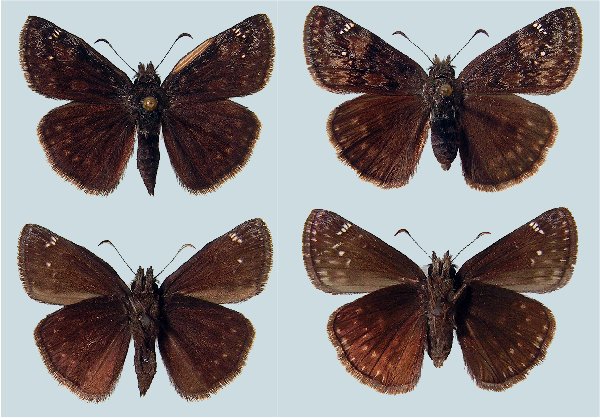Erynnis afranius

Photo Life History: Erynnis afranius
Habitat: Mountain Canyons
Host Plants: Hedysarum boreale
Suitable Lab Host Plants:
Caring for Live Female Butterflies: Nectaring techniques
Methods of Female Oviposition: Erynnis females can be somewhat uncooperative at laying eggs in captivity.
How to Find Eggs: Can be quite difficult because of how many leaves you need to look on Hedysarum boreale. Since larvae construct nests, it is advisable to look for larvae.
How to Hatch Eggs: Consolidate eggs into one container.
How to Find Caterpillars in the Field: Look for Skipper Nests; Larval nests of Erynnis afranius can be quite conspicuous on the host plant.
Caterpillar setups: Using the open terrarium or open bucket technique.
Larva to Pupa: Larva Changes Color before hibernating as mature last instar caterpillar. Most larvae reared in the lab will go through to pupa. This is one of the fastest feeding Erynnis species. Whereas some oak-feeding Erynnis larvae mature in 3-4 months, Erynnis afranius larvae can grow from first instar to pupa in only a few weeks.
How to Find Pupae in the Field: Look for Skipper Nests
Number of Broods per Year: 2-3 depending upon location.
Overwintering Stage: Mature Fifth Instar Larva
Overwintering Strategies: Your Own Backyard. (Expose larvae to intermittent humidity and some airflow.)
Post-Hibernation Strategies: Expose post-diapause larvae to warmer temperatures and intermittent humidity. Larvae will then pupate.
Avoiding Diapause Techniques: Healthy Host Plant. Because E. afranius is multivoltine, it's difficult to induce diapause with larvae. They usually go straight through to adult in the lab.
Disease Prevention: Change out host plant and remove frass every four to five days using the open terrarium technique.
Emergence: Emergence Container
Field Notes: Larvae found in the feeding in the late summer and fall usually are feeding on host that is quite stressed. These larvae diapause smaller than spring and summer individuals creating smaller adults the next spring.


